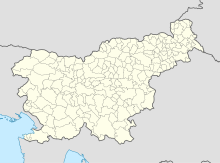Križevci (Gornji Petrovci)
Coordinates: 46 ° 47 ′ 37.7 " N , 16 ° 14 ′ 31.1" E
Križevci (Hungarian Tótkeresztúr , German Holy Cross ) is a village and a district of the municipality of Gornji Petrovci in Goričko , the hilly part of the historic Prekmurje region in Slovenia .
geography
The place occupies the central part of the northern region of the Goričko hills and valleys. The widely scattered settlement encompasses the entire headwaters of the Mala (small) Krka river and is spread over five hills and four stream valleys. The village is about 3 km south of the community center of Gornji Petrovci and is easily accessible from the main road 355, Murska Sobota - Hodoš . On the hill Vrej (350 m) a small center has formed around the Protestant parish church. Almost the entire village area can be viewed from here, with its varied fields of mixed forests, fields, meadows, vineyards and orchards.
The individual collections of homesteads and settlement groups have old field names. The most interesting and worth knowing are: Pečajni, Gergarovi, Novakovi, Vogrinkina sera, Židovska sera, Šoštarna sera, Casarni, Askini, Gorenji Konec, Ovčekovi, Kovcin breg, Vrej, Zlak, Vučki dol and Rapčin breg.
At the beginning of the 20th century, Križevci was the most populous village in Goričko. Since the Second World War, the population of the settlement has declined significantly due to poor working conditions and the remoteness of the place.
history
The place is mentioned for the first time in 1405 as "Kerezthwr", at the same time a "Mykola de Kerezthwr" is mentioned, a small village aristocrat or free farmer. 1444 "Ladislaus de Keresthwr", 1564 "Olah de Kerezthwr", 1483 "Ladislaus de Keresthwr" and 1500 "Stephani Megyesfy de Kerezthwr".
In a visitation protocol of the Diocese of Győr / Raab, the place name Totkeresztur is documented for the year 1698, and it is also recorded that the branch church of the Holy Cross was assigned to the parish church of St. Benedict ( Kančevci ).
In 1781, Emperor Joseph II issued the tolerance patent , and two years later the newly founded evangelical parish of Križevci was able to start pastoral care as the parish center for 21 settlements in Goričko. The new evangelical parish church on Vrej hill was consecrated in 1785 and in 1790 the evangelical parish of Križevci already had 3888 believers. Around 1872 the old, formerly Catholic Church of the Holy Cross was demolished and the cemetery around it abandoned. The church was on the left side of the Mala Krka at a crossroads below the small hill Židovska sera.
In 1890 the village is officially called Tótkeresztúr and had 929 inhabitants, 902 of them known as Slovenes, 20 as Hungarians and 7 as Germans. The place belonged to the Muraszombat district (today Murska Sobota) and was in the Hungarian county of Vas / Eisenburg.
The Trianon Treaty gave the village to the Kingdom of SHS . For the place now officially called Križevci, the following data were determined in the census on January 31, 1921: 1090 Slovenes, 21 Hungarians, 3 Germans, 3 other ethnic groups, of these 1117 residents 28 professed to be Catholic and 1080 to the Protestant faith counted: 2 Calvinists , 5 Jews and 2 non-believers.
The 1931 census found 971 inhabitants, in 1961 there were 780 and the following figures are known for 1971: 780 inhabitants, 206 houses, 211 households and 649 villagers who live exclusively on agricultural income. In 1991 there were still 507 residents and in 2002 only 437 people lived in this remote village.
Personalities
- Milan Kučan (born January 14, 1941 in Križevci), Slovenian politician and statesman; he was the first president of the Republic of Slovenia from 1991 to 2002 and is married to Štefka Kučan.
- Viljem Kerčmar (born July 10, 1951 in Križevci), theologian and author.
- Dušan Škedl (born March 9, 1924 in Križevci), Slovenian publicist and actor.
literature
- Ivan Zelko , Historična Topografija Slovenije I. Prekmurje do leta 1500. Murska Sobota, 1982.
- Matija Slavič, Naše Prekmurje. Murska Sobota, 1999.
- Atlas Slovenije, Ljubljana, 1985.
Web links
Individual evidence
- ↑ Lumtzer, Viktor / Melich, Johann; German place names and loan words from the Hungarian vocabulary. Sources and research on the history, literature and language of Austria and its crown lands; Publishing house of the Wagner University Bookstore Innsbruck, 1900.

